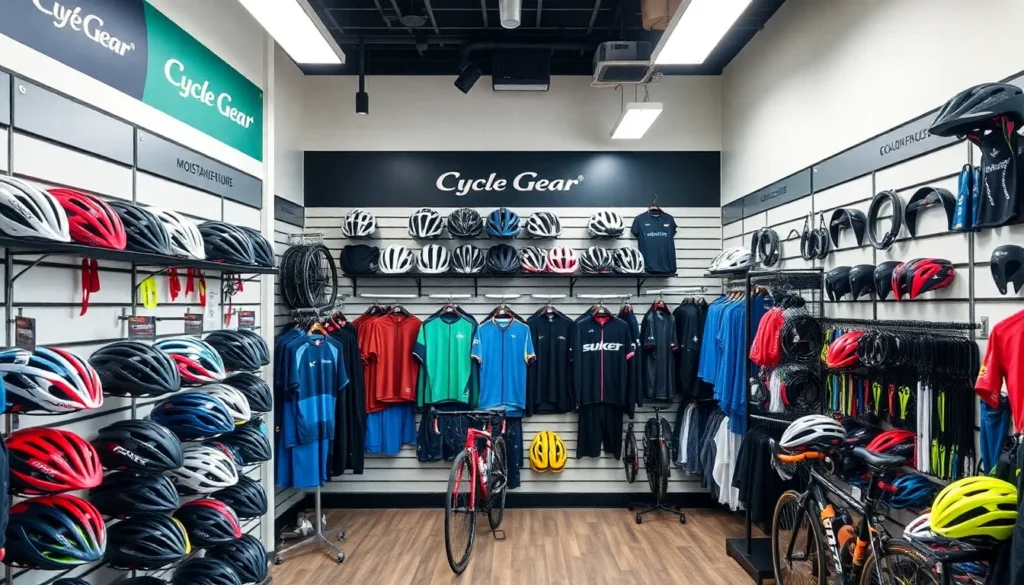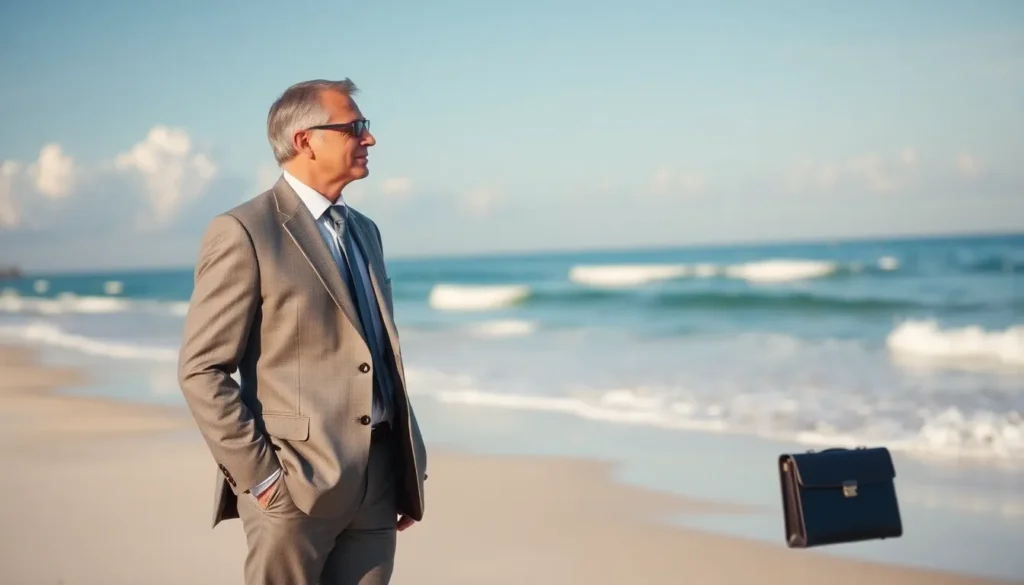In a world where plastic straws seem to have more social media followers than some celebrities, the quest for sustainable gear has never been more crucial—or more stylish. Imagine strutting into the great outdoors with gear that not only looks good but also saves the planet. It’s like wearing a superhero cape without the awkward spandex!
Sustainable gear isn’t just a trend; it’s a lifestyle choice that can make anyone feel like an eco-warrior. From biodegradable tents to recycled backpacks, the options are as diverse as the wildlife they help protect. So why not gear up with products that let you enjoy nature while giving Mother Earth a high-five? Dive into the world of sustainable gear and discover how to tread lightly while making a big impact.
Table of Contents
ToggleWhat Is Sustainable Gear?
Sustainable gear refers to outdoor equipment designed with environmentally friendly practices in mind. These products incorporate renewable materials and ethical production methods, minimizing negative impacts on the environment. Biodegradable tents demonstrate one type of sustainable gear, breaking down naturally after disposal. Recycled backpacks represent another, utilizing post-consumer waste to reduce resource consumption.
Transparency in sourcing materials reflects a key aspect of sustainable gear. Brands committed to eco-friendliness often provide information about their supply chains. For instance, some manufacturers use organic cotton or recycled plastics to create durable and stylish outdoor essentials. Their efforts contribute to reducing landfill waste and conserving resources.
Durability plays a crucial role in the sustainability of gear. Well-made products tend to last longer, decreasing the frequency of replacement and waste generation. Many sustainable gear offerings focus not just on eco-friendly materials but also on longevity. This approach emphasizes the importance of investing in quality over quantity.
Supporting local economies often occurs with the purchase of sustainable gear. Many brands partner with artisan communities, providing fair wages while promoting traditional craftsmanship. This not only empowers local artisans but also fosters cultural preservation. Eco-conscious consumers increasingly recognize the value of choosing products that reflect their values.
Sustainable gear embodies a commitment to the environment and ethical practices. By choosing such products, individuals contribute to a more sustainable future while enjoying outdoor experiences.
Benefits Of Using Sustainable Gear

Sustainable gear offers numerous benefits that positively influence both the environment and the economy. Emphasizing eco-friendly practices provides an opportunity for individuals to make a meaningful impact.
Environmental Impact
Using sustainable gear significantly reduces environmental harm. Products like biodegradable tents and recycled backpacks contribute to less waste in landfills. Nature benefits from the use of renewable materials, which help restore ecosystems. Sourcing materials transparently ensures ethical practices throughout the supply chain. Companies dedicated to sustainability often produce items with a longer lifespan. This durability means fewer replacements, reducing environmental footprints. Choosing sustainable options fosters conservation and promotes biodiversity.
Economic Advantages
Investing in sustainable gear supports local economies while encouraging fair wages. Many brands collaborate with artisan communities, strengthening local craftsmanship. Increased demand for sustainable products drives innovation in green technology. Jobs related to sustainable gear production often provide higher labor standards. This commitment to local sourcing boosts regional economies. Shoppers may notice that sustainable gear often offers better longevity, which equates to cost-effectiveness over time. Ultimately, choosing sustainable gear promotes both economic growth and environmental responsibility.
Types Of Sustainable Gear
Sustainable gear encompasses various categories tailored for eco-conscious consumers. Each category plays a vital role in reducing environmental impact while enhancing outdoor experiences.
Clothing And Apparel
Sustainable clothing often utilizes organic cotton, hemp, or recycled polyester. Brands prioritize eco-friendly dye processes that minimize water use. Additionally, multi-functional design features increase longevity and versatility in garments. Many companies offer repair services or exchanges to prolong product life. Purchasing second-hand apparel further supports the sustainability movement, as it reduces waste and resource consumption.
Outdoor Equipment
Eco-friendly tents and sleeping bags represent significant advancements in outdoor gear. These products frequently use recycled materials or renewable resources, like bamboo and cork. Durability stands out as a key feature in sustainable outdoor equipment, ensuring reliable performance over time. Many brands emphasize responsible disposal practices, encouraging consumers to return gear at the end of its life cycle. Investing in high-quality equipment reduces the frequency of purchases, ultimately lowering environmental footprints.
Accessories
Accessories including backpacks, water bottles, and cookware exemplify sustainable design principles. Many brands incorporate recycled plastics or sustainable materials into their products. Functionality merges with eco-friendliness in designs that promote reuse and reduce single-use items. Customizable options provide versatility, allowing users to adapt products for varying outdoor activities. Supporting brands committed to transparency in their supply chain fosters ethical consumption practices.
Best Brands For Sustainable Gear
Numerous brands prioritize sustainability in their outdoor products. Patagonia leads the way with innovative materials and commitment to environmental causes. Their use of recycled fabrics and fair labor practices sets a benchmark in the industry.
Another top contender, The North Face, incorporates recycled materials in its range of outdoor gear. Their commitment to reducing overall environmental impact is evident through initiatives such as the Clothes the Loop program, promoting recycling of old gear.
REI also champions sustainable practices, offering a selection of eco-friendly products. This brand not only focuses on sustainable sourcing but also emphasizes durability, ensuring that products withstand the test of time, which simplifies the decision-making process for outdoor enthusiasts.
Columbia combines functionality with sustainability, utilizing water-repellent technologies free of harmful chemicals. Its Eco-Collection features responsibly sourced materials, making it a favorite among eco-conscious consumers.
Another noteworthy brand, prAna, commits to sustainable fashion by using organic cotton and offering fair trade options. This dedication inspires shoppers to embrace an eco-friendly lifestyle while enjoying stylish outdoor apparel.
Finally, tent and gear manufacturer Big Agnes focuses on creating lightweight products using recycled materials. Their designs emphasize versatility and durability, making it easy for outdoor adventurers to select top-quality gear.
These brands exemplify the commitment to sustainability within the outdoor industry, making them stand out for consumers seeking environmentally friendly options. By choosing products from these companies, individuals contribute to a growing movement that values sustainability and ethical practices in the outdoor world.
How To Choose Sustainable Gear
Choosing sustainable gear involves evaluating various factors that influence environmental impact. Selecting products made from eco-friendly materials is essential.
Materials To Look For
Organic cotton stands out for clothing due to its lack of harmful pesticides. Hemp offers durability and requires minimal water for growth. Recycled polyester and nylon, derived from post-consumer plastics, significantly reduce waste. Sustainable gear might also use biodegradable alternatives like Tencel, which breaks down over time. Brands focused on sustainable practices increasingly utilize materials sourced through responsible methods that support local economies. Assessing the source of materials enhances transparency and reduces the overall footprint of outdoor gear.
Certifications And Labels
Certifications signify a commitment to sustainability. Look for the Global Organic Textile Standard (GOTS) label, which ensures organic fiber use and safe manufacturing processes. The OEKO-TEX certification guarantees textiles are free from harmful substances. Additionally, the Fair Trade Certified label indicates ethical labor practices and fair wages for workers. When considering gear, brands with these certifications demonstrate reliability in adhering to sustainable standards. These labels aid consumers in making informed choices that positively impact both the environment and society.
Embracing sustainable gear is more than a trend; it’s a commitment to preserving the planet for future generations. By choosing products that prioritize eco-friendly materials and ethical practices, individuals can enjoy their outdoor adventures while making a positive impact.
Supporting brands that value transparency and sustainability not only enhances outdoor experiences but also fosters a community dedicated to responsible consumption. Each purchase contributes to a larger movement that champions environmental stewardship and economic growth.
As awareness of sustainability continues to rise, the choice of eco-friendly gear becomes increasingly vital. It’s an opportunity to align personal values with actions that protect the environment and promote a healthier planet.









